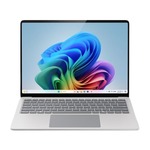Microsoft Surface Laptop 7th Edition, Snapdragon X Plus, 16 GB RAM, 256 GB SSD. $1498 but comes with $200 Harvey Norman gift card.
- Snapdragon X Plus (10-Core, not the 12-Core X Elite)
- 16 GB RAM (soldered)
- 256 GB SSD (user-replaceable, M.2 2230)
- 13.8" 120 Hz LCD display
- Sensel Haptic Touchpad
- 301 x 220 x 17.5 mm
- 1.342 kg
This is the lowest-end SKU of the Surface Laptop, and they're removing this base model in the US - I'm guessing we'll follow shortly, meaning it'll start at the pricier 512 GB ($2199 RRP, typically seen on sale for $1698 - $1748).
If you include the value of the gift card, this is an ATL for this specific base model. Platinum only for this SKU. Originally released June 2024.
The 256 GB is user-replaceable, by removing the feet (no glue), unscrewing the bottom panel, and replacing the 2230 drive.
Note that this is the Surface Laptop 7th Edition, NOT the newly-announced Surface Laptop 13".
If you're looking for a Windows competitor to a MacBook Air, this is honestly the closest thing we have; this value is pretty good considering the fit & finish you're getting at this price point.


Something to call out here is that this is an ARM processor not an x86 processor.
Running Windows 11 on an ARM-based Snapdragon laptop differs significantly from running it on a traditional x86 system, primarily due to the underlying processor architecture. ARM devices are designed for power efficiency and mobility, offering excellent battery life, fanless designs, and features like instant-on and integrated 5G. These make ARM laptops ideal for users who prioritize portability and long-lasting performance on the go.
However, app compatibility is a key consideration. While Windows 11 on ARM supports native ARM64 apps and can emulate both x86 and x64 applications, emulated apps may not perform as well as they would on a native x86 system. This can affect performance, especially for heavier or older software that hasn’t been optimized for ARM. On the other hand, x86 systems run the full range of Windows applications natively, making them more suitable for users who rely on legacy software or need maximum performance.
In terms of user experience, ARM laptops shine in light productivity, web browsing, and media consumption, while x86 machines are better suited for demanding tasks and broader software compatibility. As more developers optimize their apps for ARM, the gap is narrowing, but for now, the choice between ARM and x86 largely depends on your specific needs and software requirements.